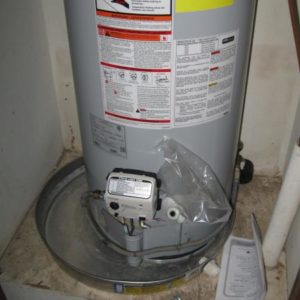Hot Water Heater safety valve plumbed to drip pan
Had a small town plumber put in a new 40 gallon, natural gas, water heater. He plumbed the drip pin under it into the condensation line for the Central A/C and changed the safety valve’s thread to a fit a 1/4″ copper line. He ran the line inside the 3/4 PVC condensation line of the A/C system as shown int the picture, but did not plumb the drip pan…..
When I questioned paying $200 plus the cost of the water heater, he came back, plumbed the drip pan into the A/C condesation line, and ran the safet valve discharge line straight down into the drip pan and said that way was “normal”.
In Texas, is this final way normal?
Thanks,
Bill




















Replies
Generally code requires that the T&P valve be plumbed such that one can visibly see any discharge, so it makes no sense that he originally ran this into the condensation drain.
Re "condensation line", does that drain outside by gravity, or does it run to a condensation pump? It would be unwise to feed the pan (and T&P valve discharge) into a condensation pump, as the pump is not designed to handle large volumes, nor is it designed to handle (scalding) hot water.
added pics below
added pics
Pics and "The Rest of the Story"
BilljustBill wrote:
No pump, just gravity flow. I'm not sure where the line goes, but have never known of an issue of the A/C coil pan not draining.
What started this plumbing was a jet of water from the cold input flex tube of the 40 gallon water heater. For an unknown amount of time the jet of water disolved a hole in the water heater closet's drywall about the size of almost a tennis ball, the proceeded to disolve the drywall behind it that is a walk-in closet. That hole was about the size of half dollar.
Haven't seen the flex tube to understand what caused it as the neighbor that came to help the 90 yr. old owner took it with him while getting a replacement. It may still be available. Just trying to figure out what happened, since that water heater and lines were only 6 years old, is that the DIY "Installer" must have put on the flex tube at the wall first. Then, being a bit too short, he flexed and bent the "shiny" flex tube (not the usual copper flex lines) to make it fit the water heater inlet. When he bent or tighted the line, it must have kinked it and formed a weak spot that eventually failed.....
End result, the leak cause 3/4 of the 1800 sq.ft. house carpeting was totaled by the insurance company. They called "Serve Pro", who came in and removed all the carpet and pad, and with 25 fans and 4 dehumidifiers running from Monday at noon to Friday at noon, they dry out the slab floors and clothing.... Moisture measures sent to the insurance company said moisture was down to 12%, which was very low and showed their overall work was top notch. Although, that type of water damage, carpet & pad removal, and daily testing did cost. The Serve Pro bill was just over $5,000.
I really didn't want another "water issue", so that's why I'm asking about the quality of the the installation of the new water heater's plumbing. Prior to the plumber employee coming back, the owner of the plumbing company had said that since the water heater closet was in the middle of the home, they may have to run a line into the attic and exiting the soffit with a short stub. But, as I described, that's how they ended up handling it with a charge of another $102.00.....
Thanks for your insight and time,
Bill
It looks like the original unit was probably plumbed with non-flex copper, and when the unit was replaced last the bozo used inappropriate pieces of flex -- should have either used non-flex again, or used flex long enought to make a smooth loop. And, of course, the type of line used was not the best choice -- should have been the stainless steel braid, as the copper lines are known to develop pinholes.
Thanks for answering. I found out that the "faulty" flex line has be found, so in a few weeks I'll be able to understand how it failed or if its failure was due to how it was installed.
Any other comments are always welcome.
ONE QUESTION OF THE SITE: How does one 'cut and paste' or activate the spell checker?
Thanks again, Bill
Bill
Spell checker? Don't think there is one
SourceNormalFontSize
You might try farting around with the "editor box" . The scissors might mean "cut" , the 2pages might be copy, the next 2 beats the heck out of me, but the last seems like it might resemble spellcheck.
on an iPad, you hold your finger on the screen and sometimes you get some options......
remember, this software was new sometime in the last century and no one here feels enough proud to mess with imperfection.
EDIT: Take a look at the mumble jumbo above, that's my attempt to copy/paste the "editor" bar located above the reply box........
Water Heater install
Let me try again. From the 2012 UPC:
507.5 Relief Valve Discharge. Discharge from a relief valve
into a water heater pan shall be prohibited.
608.S Drains. Relief valves located inside a building shall
be provided with a drain, not smaller than the relief valve
outlet, of galvanized steel, hard-drawn copper piping and
fittings, CPVC, PP, or listed relief valve drain tube with 1'it- I
tino-s that will not reduce the internal bore of the pipe or
tubing (straight lengths as opposed to coIls) and shall
extend from the valve to the outside of the building, with
the end of the pipe not more than 2 feet (610 mm) nor Jess
than 6 inches (152 mm) aboveground or the flood level of
the area receiving the discharge and pointing downward.
Such drains shall be permitted to terminate at other
approved locations. Relief valve drains shall not terminate
in a building's crawl space. No pm1 of such drain pipe shall
be trapped or subject to freezing. The terminal end of the
drain pipe shall not be threaded.